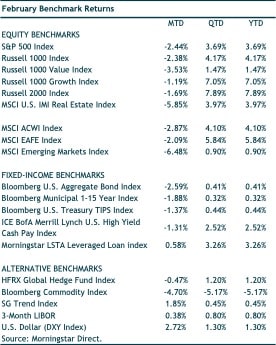March 2023 Market Commentary
- After a strong start to the year, global equity markets gave back some of those gains in February
- An appreciating US dollar negatively impacted foreign equity returns—resulting in outperformance by US markets
- Resilient economic data continue to come in, which is quelling hopes that we’ve seen peak interest rates
- Investors spent much of February updating their assumption of the Fed’s terminal rate in this cycle—leading to much higher rates across the entire US Treasury curve
MARKET RECAP
Equity markets fell during the month, dragged lower by growing concerns Fed policy will need to be tighter than previously thought. The S&P 500 fell 2.4% in February. Despite higher rates and increased expectations that rates would be higher in the future, technology stocks fared better. The tech-heavy NASDAQ Composite fell just 1%—whereas large cap value stocks dropped 3.5%. Despite a stronger US dollar (the DXY Index rose 2.7%), developed international stocks (MSCI EAFE) did a bit better than the US market in February dropping 2.1% (but with slightly positive returns in local currency terms). Emerging-markets stocks were the worst performer in February with a drop of 6.5%. Chinese equities had enjoyed strong gains in recent months thanks to a reversal of their zero-COVID policies. However, Chinese stocks fell 10.4% (MSCI China) in February, giving back some of those gains.
Higher interest rates across the maturity curve led to losses in the fixed income markets during February. The Bloomberg US Aggregate Bond Index lost 2.6%. Duration underperformed last month (long-dated US Treasuries down 4.7%) as rates on the longer-end of the curve picked up some steam—though they still remain below the short-end. Riskier credit outperformed the core bond index thanks to both credit spreads that remained contained, as well as shorter durations for many bonds in the high-yield market. The ICE BofA US High Yield market fell 1.3%.
NOTABLE EVENTS
February was marked by hotter-than-expected economic readings that resulted in concerns that the Fed might further tighten policy (and keep it there for longer than expected). In early February, the strong jobs market data (nonfarm payrolls increased by 517,000 versus 189,000 consensus estimate) sent markets lower. The unemployment rate fell to 3.4%—the lowest figure since 1969!
The strength of the labor market continues to fly in the face of consensus expectations for recession this year. Going into recessions the economy is typically shedding jobs but that has yet to happen. However, there have been recessions where it takes time for job growth to contract. In a recent interview, Lakshman Achuthan (co-founder Economic Cycle Research Institute), noted two recessions that saw jobs growth early in the recession. During the 1973-1975 recession, he said it took eight months from the official start date of the recession for nonfarm payrolls to go negative. The 1980 recession had positive non-farm payrolls for the first two months. Both recessions were also marked by high inflation.
Achuthan goes on to say that during inflationary recessions, the jobs market may experience initial strength because of a “money illusion” that stems from strong nominal revenue growth. Businesses may be enamored with double-digit revenue growth and, as a result, happy with their employment pool. However, the real value of those revenues is substantially lower and at the same time costs are increasing—resulting in deteriorating profitability. Based on recent estimates, the S&P 500 nominal revenue growth is expected to grow 10% in 2022 (while trailing 12-month GAAP earnings are expected to have fallen 13% last year). Furthermore, the S&P 500 2022 estimate of operating margins contracted nearly 300 basis points (13.4% down to 10.8%). Thus, high nominal revenues—in conjunction with the ongoing difficulty to hire due to aftermath of the pandemic—may be buoying the labor market for the time being.
Other economic figures that the market paid particular attention to included January’s consumer spending report and the Fed’s preferred measurement of inflation (core PCE). Consumer spending in January increased 1.8%, its highest figure in almost two years. Consumer spending represents two-thirds of the US economy and is thus an important driver of the economy. January’s core PCE came in at 4.7%, which was higher than December’s reading of 4.6%. The consensus estimate for January’s core PCE figure was 4.3%.
These economic readings, among other factors, resulted in a repricing of interest rate expectations by the market and losses in the fixed income market. At the start of February, the futures market was assuming the Fed funds rate would peak at 4.75%-5% over the summer and there might be rate cuts by the end of the year. However, by the start of March, there was similar odds for rates to be 5.25%-5.5% or 5.5%-5.75% at the late-July meeting. This would mean an additional four hikes of 25 basis points over the next four FOMC meetings.


